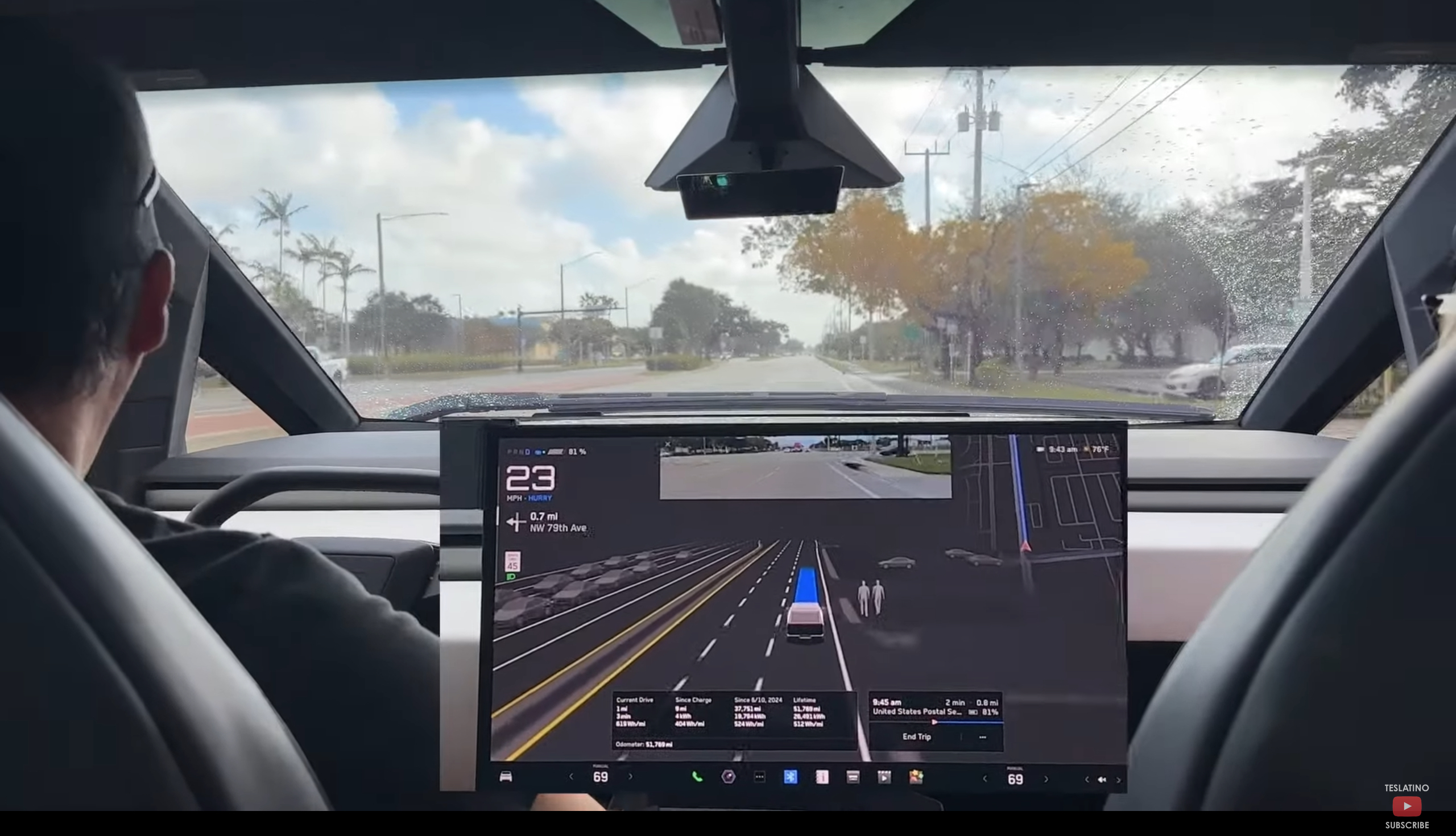
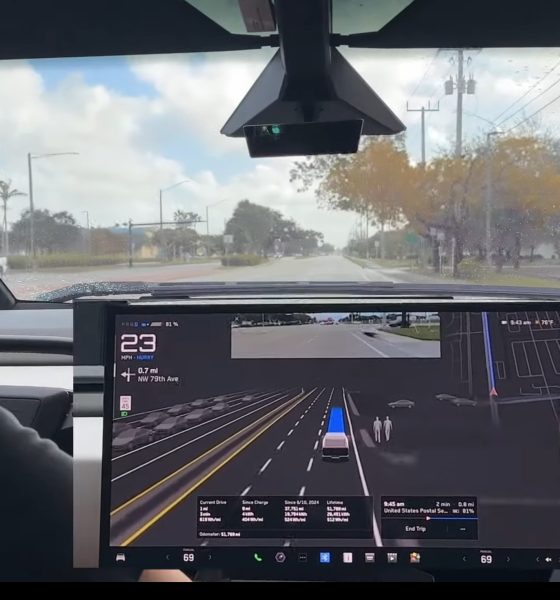
News
Tesla rolls out latest FSD version, shares upcoming HW3 deployment plans
Tesla has begun rolling out its latest version of Full Self-Driving (FSD) Supervised this week to those with its most recent computer hardware, along with providing an update on when those with older FSD computers can expect new updates.
While Tesla began rolling out its FSD Supervised v13 a couple of weeks ago, the company has begun a wider rollout of its latest version, FSD Supervised v13.2.1, to those with Hardware 4 (HW4), or AI4, computers, as confirmed by Autopilot program lead Ashok Elluswamy on X on Monday.
Those with Hardware 3 (HW3)—often called AI3 after Elon Musk dubbed upcoming the FSD computers with AI rather than HW during this year’s Shareholder Meeting—are also set to get a new version before the end of the year, according to Elluswamy.
“FSD v13.2.1 is now rolling out wide to AI4 customers! That plus the holiday vehicle software update is coming within a week,” he wrote. “Team’s working on a much updated v12.6 for AI3 customers by end of this year.”
READ MORE ON TESLA’S FSD SUPERVISED: Tesla is working on new parking features for Full Self-Driving
The news comes as many Tesla owners with older vehicles have criticized the company for rolling out new, well-performing FSD Supervised versions only to those with newer vehicles and internal computers, with Elluswamy’s response highlighting that the company is still debuting new versions for those with the older hardware.
Although Musk also said during the meeting that there was a slight chance that Unsupervised FSD may never be able to run on AI3 vehicles, he emphasized that, if that were the case, Tesla would upgrade AI3 vehicles whose owners purchased FSD. The Tesla CEO has also said that AI5 is expected to be used in Optimus and all newly produced cars by the end of 2025.
Initial reviews of Tesla’s FSD Supervised v13
Tesla’s FSD Supervised v13.2.1 follows the debut of v13 and v13.2, which have been garnering positive reviews since the initial version was first launched just weeks ago. In addition to going from park-to-park in the v13 suite, the software has been spotted navigating some tricky situations that past versions didn’t seem to be capable of handling.
Early reviews of FSD Supervised v13.2.1 have been similar, with some sharing video of their cars avoiding road obstacles, cautiously navigating around other vehicles making traffic violations, and more while using the software. You can see one particular review below, courtesy of X user Greggertruck, who was using the software while driving his Cybertruck.
Cybertruck just totally avoided some junk in the turn lane, waiting to switch until it passed. ? Obstacle avoidance seems improved in FSD V13.2.1 you’re wild @Tesla_AI pic.twitter.com/zajda8jRvK
— Greggertruck (@greggertruck) December 16, 2024
Tesla has been rolling out Cybertruck FSD updates at slightly different times than for most other AI4 vehicles, and the recent release of v13.2.1 also came with slightly different release notes than those seen in Model Y and other vehicles.
FSD 13.2.1 release notes Y vs Cybertruck
Same FSD release, different release notes pic.twitter.com/mmTmBIEP28— Dirty Tesla (@DirtyTesLa) December 15, 2024
For one, the release notes don’t include the integrated unpark, reverse, and park capabilities that make the version go from “park-to-park.” Additionally, it doesn’t feature the highly anticipated Actually Smart Summon, which is expected to come with a future update.
You can watch more footage of early FSD Supervised v13.2.1 experiences below from Teslatino, who uses the software to drive to the Post Office in his Cybertruck.
What are your thoughts? Let me know at zach@teslarati.com, find me on X at @zacharyvisconti, or send us tips at tips@teslarati.com.
Tesla highlights FSD safety in edge case test videos
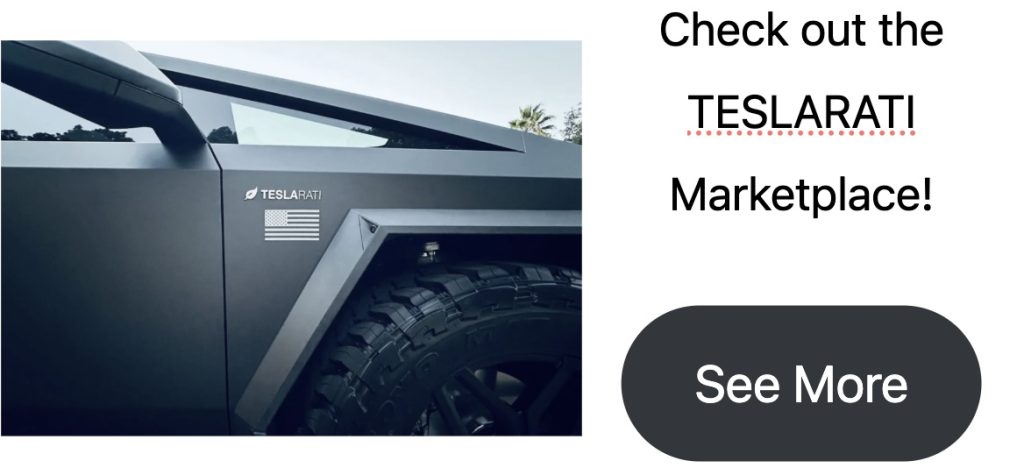
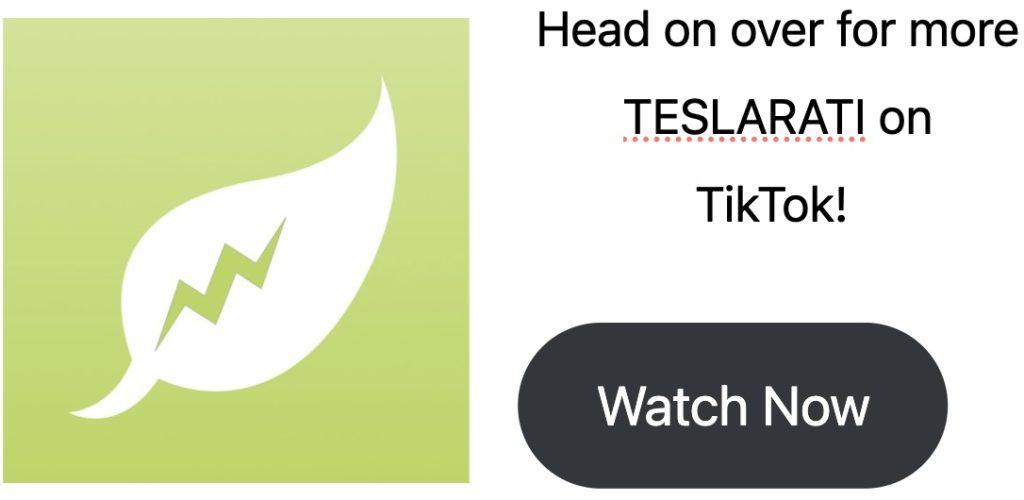

News
Swedish union rep pissed that Tesla is working around a postal blockade they started
Tesla Sweden is now using dozens of private residences as a way to obtain license plates for its vehicles.

Two years into their postal blockade, Swedish unions are outraged that Tesla is still able to provide its customers’ vehicles with valid plates through various clever workarounds.
Seko chairman Gabriella Lavecchia called it “embarrassing” that the world’s largest EV maker, owned by CEO Elon Musk, refuses to simply roll over and accept the unions’ demands.
Unions shocked Tesla won’t just roll over and surrender
The postal unions’ blockade began in November 2023 when Seko and IF Metall-linked unions stopped all mail to Tesla sites to force a collective agreement. License plates for Tesla vehicles instantly became the perfect pressure point, as noted in a Dagens Arbete report.
Tesla responded by implementing initiatives to work around the blockades. A recent investigation from Arbetet revealed that Tesla Sweden is now using dozens of private residences, including one employee’s parents’ house in Trångsund and a customer-relations staffer’s home in Vårby, as a way to obtain license plates for its vehicles.
Seko chairman Gabriella Lavecchia is not pleased that Tesla Sweden is working around the unions’ efforts yet again. “It is embarrassing that one of the world’s largest car companies, owned by one of the world’s richest people, has sunk this low,” she told the outlet. “Unfortunately, it is completely frivolous that such a large company conducts business in this way.”
Two years on and plates are still being received
The Swedish Transport Agency has confirmed Tesla is still using several different workarounds to overcome the unions’ blockades.
As noted by DA, Tesla Sweden previously used different addresses to receive its license plates. At one point, the electric vehicle maker used addresses for car care shops. Tesla Sweden reportedly used this strategy in Östermalm in Stockholm, as well as in Norrköping and Gothenburg.
Another strategy that Tesla Sweden reportedly implemented involved replacement plates being ordered by private individuals when vehicles change hands from Tesla to car buyers. There have also been cases where the police have reportedly issued temporary plates to Tesla vehicles.
News
Czech Deputy excited for Tesla FSD, hints at Transport Committee review
The ANO party lawmaker shared his thoughts about FSD in a post on social media platform X.
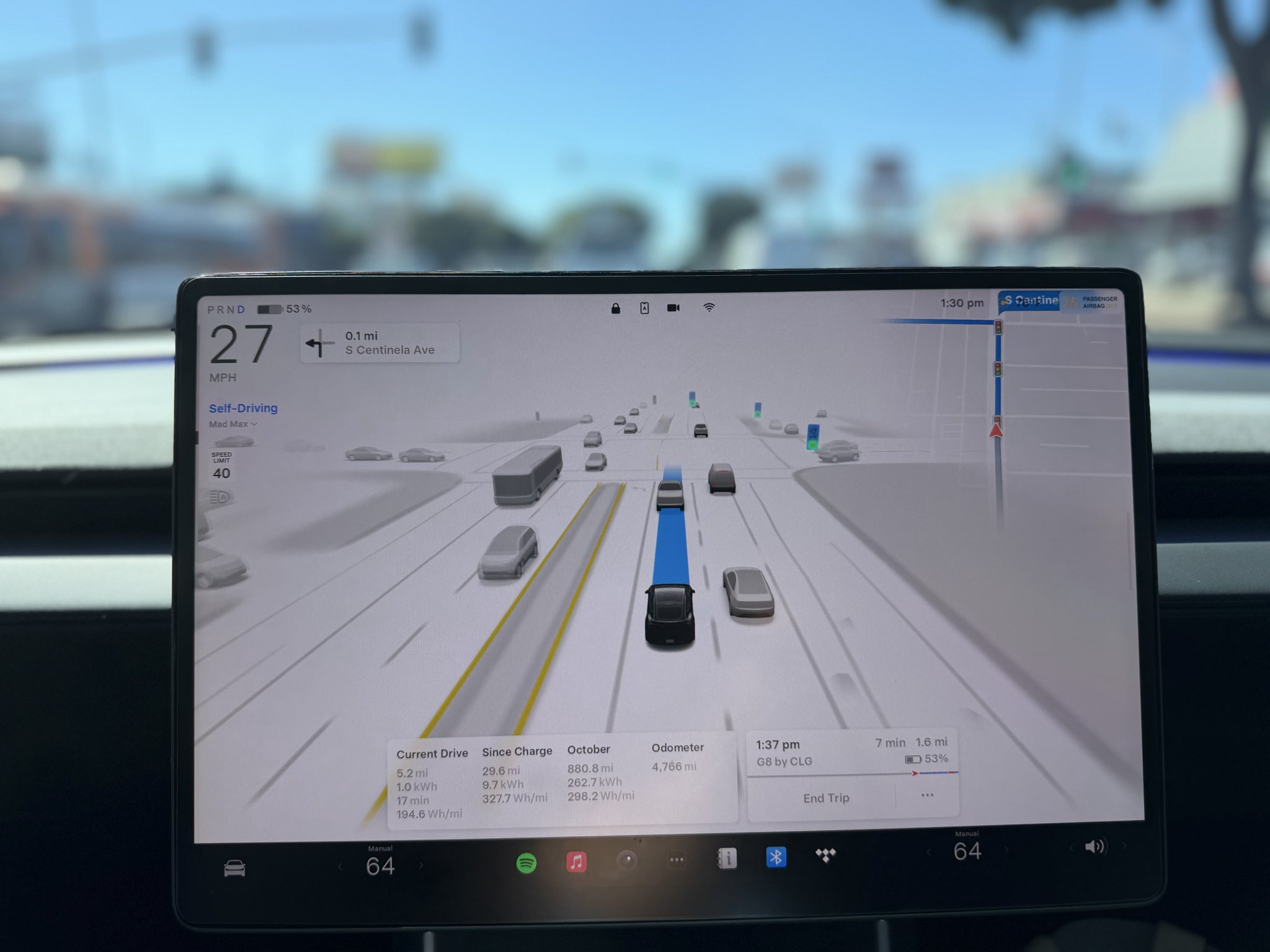
Martin Kolovratník, a Czech Republic Chamber of Deputies member, has expressed his excitement for Tesla’s Full Self-Driving (FSD) after an apparent constituent called for a quick approval for the advanced safety system.
The ANO party lawmaker, who drives both diesel and EV, shared his thoughts about the matter in a post on social media platform X.
The official’s initial statements
Kolovratník kicked off the exchange with a post outlining his coalition’s efforts to scrap highway toll exemptions for electric vehicles and plug-ins starting in 2027.
“Times have changed. Electric vehicles are no longer a fringe technology, but a full-fledged part of operations. And if someone uses the highway network, they should follow the same rules as everyone else. That’s the basis of fairness,” he wrote.
He emphasized equity over ideology, noting his personal mix of diesel and electric driving. “For this reason, there is no reason to continue favoring one technology at the expense of another… It’s not about ideology, it’s about equal conditions. That’s why we clearly agreed within the new coalition: the exemption for electric vehicles and plug-ins will end in 2027. The decision is predictable, understandable, and economically sound.”
Tesla FSD enthusiasm
The conversation pivoted to Tesla’s FSD when X user @robotinreallife, who seems to be one of the official’s constituents, replied that other matters are more important than ending highway exemptions for EVs.
“I’m happy to pay for the highway, but I have a question about a much more fundamental matter: The Netherlands will approve the operation of Tesla FSD in February 26, a technology that has been proven to reduce accidents. The Czech Republic has the option to immediately recognize this certification. Do you plan to support this step so that we don’t unnecessarily delay?” the X user asked.
Kolovratník responded promptly, sharing his own excitement for the upcoming rollout of FSD. “I know about it. I like it and it seems interesting to me. Once we set up the committees and subcommittees, we’ll open it right away in that transport one. Thanks for the tip, I’ll deliver the report,” the official noted in his reply on X.
Kolovratník’s nod to FSD hints at the system’s potentially smooth rollout to Czechia in the coming year. With the Netherlands possibly greenlighting FSD (Supervised) in early 2026, Kolovratník’s commitment could accelerate cross-border certification, boosting FSD’s foray into Europe by a notable margin.
News
Tesla Model 3 named New Zealand’s best passenger car of 2025
Tesla flipped the switch on Full Self-Driving (Supervised) in September, turning every Model 3 and Model Y into New Zealand’s most advanced production car overnight.

The refreshed Tesla Model 3 has won the DRIVEN Car Guide AA Insurance NZ Car of the Year 2025 award in the Passenger Car category, beating all traditional and electric rivals.
Judges praised the all-electric sedan’s driving dynamics, value-packed EV tech, and the game-changing addition of Full Self-Driving (Supervised) that went live in New Zealand this September.
Why the Model 3 clinched the crown
DRIVEN admitted they were late to the “Highland” party because the updated sedan arrived in New Zealand as a 2024 model, just before the new Model Y stole the headlines. Yet two things forced a re-evaluation this year.
First, experiencing the new Model Y reminded testers how many big upgrades originated in the Model 3, such as the smoother ride, quieter cabin, ventilated seats, rear touchscreen, and stalk-less minimalist interior. Second, and far more importantly, Tesla flipped the switch on Full Self-Driving (Supervised) in September, turning every Model 3 and Model Y into New Zealand’s most advanced production car overnight.
FSD changes everything for Kiwi buyers
The publication called the entry-level rear-wheel-drive version “good to drive and represents a lot of EV technology for the money,” but highlighted that FSD elevates it into another league. “Make no mistake, despite the ‘Supervised’ bit in the name that requires you to remain ready to take control, it’s autonomous and very capable in some surprisingly tricky scenarios,” the review stated.
At NZ$11,400, FSD is far from cheap, but Tesla also offers FSD (Supervised) on a $159 monthly subscription, making the tech accessible without the full upfront investment. That’s a game-changer, as it allows users to access the company’s most advanced system without forking over a huge amount of money.









